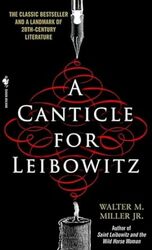
Rating: 8.4/10.
Classic science fiction novel, won the Hugo Award, written in the 1950s, portraying the aftermath of a nuclear apocalypse that spans several millennia, it has three parts, the first is 600 years after present and each part is another 600 years in the future. The novel explores how humanity undergoes dark ages, a renaissance, and then a revival before rediscovering nuclear weapons and destroying itself again.
Part one starts six centuries after a nuclear apocalypse and fallout. Humanity is in a sort of dark ages, and Brother Francis is a devoted monk studying at a monastery in the southwestern US desert. One day, he sees an old man who leads him to discover an ancient fallout shelter. There, he discovers some documents and blueprints from the creator of his monastic cult of Leibowitz, along with the documents left behind by him and his wife. They take the documents as religious artifacts to be carefully preserved. Having lost all technology, they spend their days copying and recopying the books from the lost technological era, without understanding any of the science since only fragments of the written text remain. He is questioned by various members of the church who are trying to decide whether these documents are authentic or a hoax. Eventually, they are recognized as authentic, and he is invited to meet the Pope.
Part two fast forwards another six centuries and the world is now comprised of city states that are constantly at war with each other, while also starting to rediscover scientific knowledge. The main protagonist is Thon Taddeo, a genius scholar who travels to the monastery in search of ancient texts containing scientific knowledge. At this monastery, a monk has figured out how to generate light mechanical energy, and Taddeo is able to comprehend and interpret the ancient scientific texts for the first time. However, the abbot of the monastery is apprehensive about the impending threat of scientific knowledge and the potential harm it could bring everyone, as was the case in the previous fallout (or “flame deluge”). The city states are battling each other, and there is a risk of the monastery being invaded and destroyed, a situation that he must also contend with.
Part three takes place after another six centuries. At this point, civilization has rediscovered technology, including nuclear weapons and interstellar travel. The world is on the verge of another nuclear war between superpowers, and the church starts a plan to evacuate some key religious items to a distant star system. Suddenly, the capital is bombed, resulting in millions of deaths and severe injuries, and many wounded victims flee to the monastery. Father Zerchi involves himself in various debates about the ethicality of life versus killing people letting nature run its course for hopeless cases radiation poisoning. The book concludes with the monastery being bombed as well, and Father Zerchi dies underneath the rubble of the church. The story has come full circle, and civilization has destroyed itself yet again.
There is a clear sign of the nuclear fear prevalent during the Cold War: the popular fear of nuclear war between superpowers is intensely felt throughout this novel. Its portrayal of the devastating effect of a possible nuclear war on humanity for generations to come, including the amount of human suffering, serves as a reminder of the potential consequences of nuclear warfare.
Another important theme is the relationship of the church to society. Throughout each part of the novel, society varies greatly, but the church remains relatively: its rituals are still performed in Latin, and its traditions are not meant to be fully understood, but always followed strictly. There are many phrases in Latin that are only partially understandable to the reader, but the book never translates them. Just as in real life, the Catholic Church, which has existed for thousands of years, is portrayed as remaining more or less the same for thousands more years to come. The church serves as a preserver of ancient knowledge and is conservative in sharing this knowledge with the world and adapting its rituals to changing social norms.



